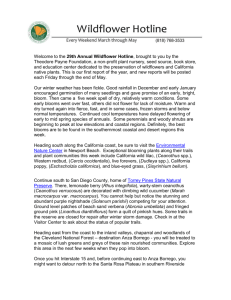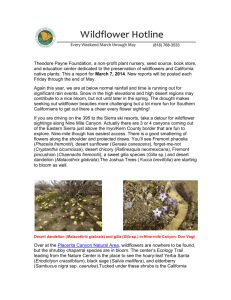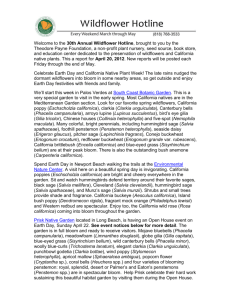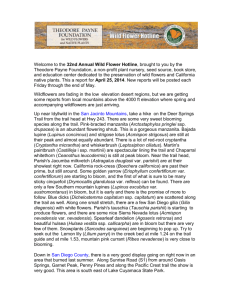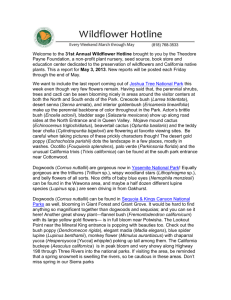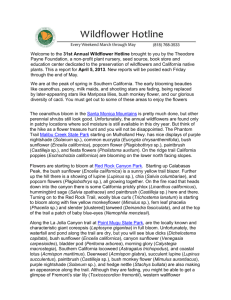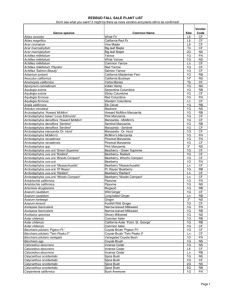doc March 8
advertisement
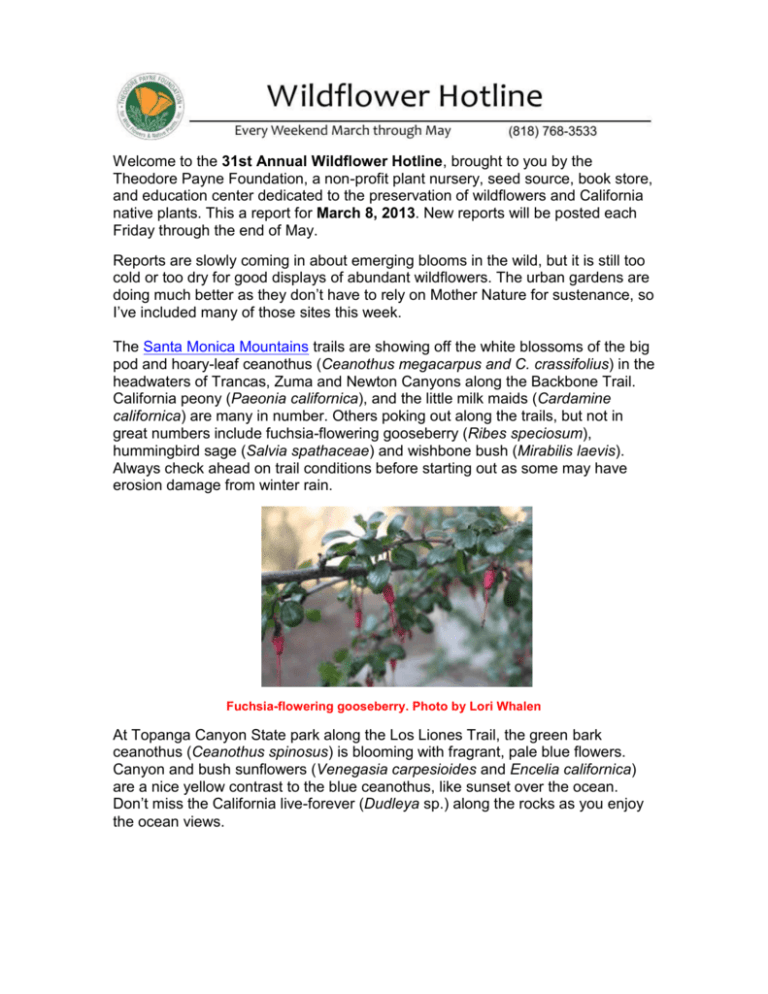
Welcome to the 31st Annual Wildflower Hotline, brought to you by the Theodore Payne Foundation, a non-profit plant nursery, seed source, book store, and education center dedicated to the preservation of wildflowers and California native plants. This a report for March 8, 2013. New reports will be posted each Friday through the end of May. Reports are slowly coming in about emerging blooms in the wild, but it is still too cold or too dry for good displays of abundant wildflowers. The urban gardens are doing much better as they don’t have to rely on Mother Nature for sustenance, so I’ve included many of those sites this week. The Santa Monica Mountains trails are showing off the white blossoms of the big pod and hoary-leaf ceanothus (Ceanothus megacarpus and C. crassifolius) in the headwaters of Trancas, Zuma and Newton Canyons along the Backbone Trail. California peony (Paeonia californica), and the little milk maids (Cardamine californica) are many in number. Others poking out along the trails, but not in great numbers include fuchsia-flowering gooseberry (Ribes speciosum), hummingbird sage (Salvia spathaceae) and wishbone bush (Mirabilis laevis). Always check ahead on trail conditions before starting out as some may have erosion damage from winter rain. Fuchsia-flowering gooseberry. Photo by Lori Whalen At Topanga Canyon State park along the Los Liones Trail, the green bark ceanothus (Ceanothus spinosus) is blooming with fragrant, pale blue flowers. Canyon and bush sunflowers (Venegasia carpesioides and Encelia californica) are a nice yellow contrast to the blue ceanothus, like sunset over the ocean. Don’t miss the California live-forever (Dudleya sp.) along the rocks as you enjoy the ocean views. Canyon sunflower. Photo by Michael Charters Zuma Ridge has prickly phlox (Linanthus californicus), paintbrush (Castilleja sp.), deer weed (Acmispon glaber), manzanita (Arctostaphylos sp.) and purple nightshade (Solanum sp.) to add to the Santa Monica Mountains flora this week. The school gardens at the Elizabeth Learning Center in Cudahy are looking spectacular and visitors are welcome to visit and enjoy. In front of the school on Elizabeth Street, there are blooming annuals—goldfields (Lasthenia sp.), chia (Salvia columbariae), owl’s clover (Castilleja sp.) desert dandelion (Malacothrix glabra), and desert bluebells (Phacelia campanularia) showing their color between the apricot mallow (Sphaeralcea ambigua), and chuparosa (Justicia californica). The Central Habitat Garden has Santa Rosa Island white-felted and the red-orange paintbrushes (Castilleja spp.). Also blooming here are the sweet little cream cups (Platystemon californicus) contrasting the pink fairy-duster (Calliandra eriophylla) and blue California wild lilacs (Ceanothus spp.). Cream cups at Elizabeth Learning Center Garden. Photo by George Nanoski Visitors are welcome to visit the campus and enjoy the flowers from 8:00am to 4:00pm Monday thru Friday. They need a visitor pass from the Main Office. We are located in Cudahy on Elizabeth Street between Atlantic Blvd and Wilcox Ave. Continue a little south of Cudahy to Long Beach to enjoy more urban oases. The Colorado Lagoon and the Jack Dunster Marine Biological Preserve both have an amazing number of blooming native plants. Sit on a park bench and enjoy watching insect pollinators on tidy tips, (Layia platyglossa), arroyo lupine (Lupinus succulentus), beach primrose (Camissoniopsis cheiranthifolia), and baby blue eyes (Nemophila menziesii). The shrubby perennials like coast sunflower (Venegasia carpesioides), bladder-pod (Peritoma arborea) are also spectacular here. The Dunster Preserve is a secluded gem of Coastal Sage Scrub habitat. Chalk dudleya, (Dudleya pulverulenta), California buckwheat (Eriogonum fasciculatum), Island snapdragon (Galvesia speciosa), several sage species (Salvia spp.), giant coreopsis (Leptosyne gigantea) and California poppy (Eschscholzia californica) provide a heady mix of floral and ocean breeze scents. Go to see the blossoms and the views of the marina, but keep an eye out for possible sea lion sighting! Jack Dunst Preserve. Photo by George Nanoski On the Palos Verdes Peninsula at South Coast Botanic Garden, the California natives reside in the warm Mediterranean Garden exhibit. The perennial shrubs of bush anemone (Carpenteria californica), conejo buckwheat (Eriogonum crocatum), bush sunflower (Encelia californica), manzanitas (Arctostaphylos spp.) and sages (Salvia spp.) provide a colorful frame for the California blue and gold of California poppy (Eschscholzia californica) and blue-eyed grass (Sisyrinchium bellum). It is truly a beautiful landscape. The main walking trails at the Environmental Nature Center in Newport are showing off yellow blossoms of bush poppy (Dendromecon rigida), flannel bush (Fremontodendron mexicanum), California coast brittlebush (Encelia californica), and Nevin’s barberry (Berberis nevenii). Also enjoy fuchsia-flowering gooseberry (Ribes speciosum) and the chaparral currant (Ribes malvaceum). There are also many, many ceanothus (Ceanothus spp.) providing waves of blue color. At Torrey Pines State Natural Preserve, sand verbena (Abronia spp.), milk maids (Cardamine californica), paintbrush (Castilleja sp.) and yellow sea dahlia (Leptosyne [Coreopsis] maritima) can be found along the trails with lemonade berry (Rhus integrifolia), warty-stem ceanothus (Ceanothus verrucosus) standing tall among them. This is a beautiful park to walk and explore. See the rare Torrey pines in their natural habitat while taking in the ocean view. Some trails in the reserve may be undergoing repair. Please check the website or drop in at the Visitor Center for more information about the trails. The cool weather stalled flowering for a while at the Santa Rosa Plateau Ecological Reserve in Riverside County, but the shooting stars, (Dodecatheon clevelandii) are just starting to peak. Look in pockets of shaded areas along the trails for milk maids (Cardamine californica), violets (Viola douglassii) and miner’s lettuce (Claytonia perfoliata ssp. mexicana). California peony (Paeonia californica) can be seen tucked under the flowering ceanothus (Ceanothus spp,) along the chaparral trails. With warmer weather on the way, you won’t want to miss hiking the area as waves of wildflowers bloom sequentially during the spring along with the promise of chocolate lilies! Again, Anza-Borrego Desert State Park should not be your destination for spectacular wildflowers. It has been dry and blossoms are sparse and short of stature. However, if you are traveling to Anza Borrego for some other reason like the Swainson Hawk Watch or to take in the grand desert geology, then the drive down the Montezuma grade will offer up sightings of desert brittlebush (Encelia farinosa), and chuparosa (Justicia californica) with a few ocotillo (Fouquieria splendens) rising above them. The show is only very near the road where water runoff adds a little extra moisture to the ground. Please use the turnouts safely if you want to get out and look close up. In the park, walk up and explore any of the north facing (and therefore moisture holding) canyons to see forget-me-nots (Cryptantha spp.), popcorn flowers (Plagiobothrys spp.), brown-eyed primrose (Chylismia claviformis), small flowered poppy (Eschscholzia minutiflora) common phacelia (Phacelia distans), purple mat (Nama demissum) and a few other species (and I do mean a few!). Check in the visitor center or the Anza Borrego Desert Natural History Association for advice on the best canyons to explore. Chuparosa and bladder pod. Photos by Michael Charters Joshua Tree National Park rangers and volunteers are noting a slow start to the wildflower season within the park boundaries. Explore the lower elevations of the park like Cottonwood Springs and Pinto Basin, and find bladder pod (Peritoma arborea) and red chuparosa (Justicia californica) showing of their yellow and red blossoms. You might have to fight off the hummingbirds though, as you try to get close-up pictures of these pretty flowers. Traveling south of JTNP through Box Springs Canyon, pull off the road and explore the washes and canyons. Yes, you will have to get out and walk around to find these! They are not abundant. Tucked around crevices and rocky canyon walls are a few hardy annuals like little golden poppy (Eschscholzia minutiflora), notch-leaf phacelia (Phacelia crenulata), brown-eyed primrose (Chylismia claviformis), common phacelia (Phacelia distans), lupines (Lupinus spp.), white fiesta flower, (Pholistoma membranaceum) desert dandelion (Malacothrix glabrata). Perennials include chuparosa (Justicia californica), wishbone bush (Mirabilis sp.), desert lavender (Hyptis emoryi), brittlebush (Encelia farinosa) and sweetbush (Bebbia juncea). Much farther east in the desert along Highway 95, it has been reported that the wildflower season is beginning with roadside annuals such as sand verbena Abronia villosa), notch-leaf phacelia (Phacelia crenulata), Mojave suncup (Camissonia campestris) and brittle bush (Encelia farinosa) starting to show color. Again, “no major outbreaks” have been reported yet. Hopefully it will come soon. But if you are driving this weekend to the River, Vegas, Phoenix or wherever east of here, take a jog on US 95 and enjoy the drive. Over at the Placerita Canyon Natural Area, the early bloomers can be found along the Ecology Trail leading from the Nature Center. Look for the hoary-leaf ceanothus (Ceanothus crassifolius) at its peak bloom along with the “ribes trifecta” fuchsia-flowering gooseberry (Ribes speciosum), chaparral currant (Ribes malvaceum) and the golden currant (Ribes aureum). Tucked under these shrubs is the California peony (Paeonia californica) and scrambling over the shrubs is the wild cucumber (Marah macrocarpa). That’s it for this week. Look for our next report on Friday, March 15 and check back each week for the most up to date information on southern and central California wildflowers. If you would like to be a wildflower reporter send your information about wildflower blooms and their location to flowerhotline@theodorepayne.org by Wednesday of each week when blooms of note occur. NATIVE PLANT & WILDFLOWER EVENTS: Theodore Payne Foundation Annual Poppy Day on Saturday, March 23, Plant Sale and Festival. 10th Annual Native Plant Garden Tour, Saturday and Sunday, April 6 & 7 from 10 am – 5 pm. For more information and tickets, visit our webpage. Huntington Library When They Were Wild: Recapturing California’s Wildflower Heritage March 9 – June 10, 2013 Mary Lou and George Boone Gallery A collaborative project of The Huntington, Rancho Santa Ana Botanic Garden, and the Theodore Payne Foundation for Wildflowers and Native Plants. For more information, go to The Huntington California Native Plant Society Chapters CNPS-San Diego Chapter Field trips: March 10 - Field Trip - Sunday Torrey Highlands and Crest Canyon Preserve More information CNPS – Los Angeles-Santa Monica Mountains Field Trip: Sunday, March 13 - 9am Royce Canyon (Griffith Park) Wildflower Hike 9:00 am -12:30 pm. For more information and program schedule, go to LA/SMM newsletter The Toyon CNPS – Orange County Chapter Field Trip: March 10, Sunday. Santiago Truck Trail Go to OCCNPS Field Trips for more information.
